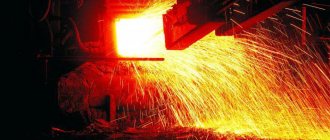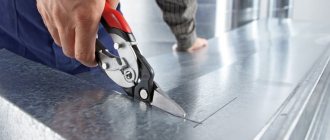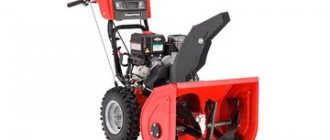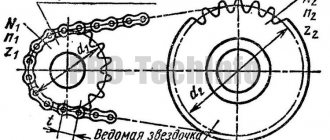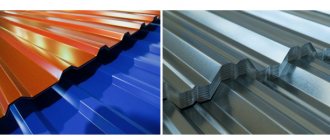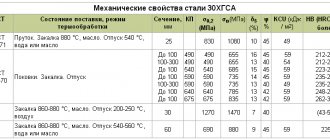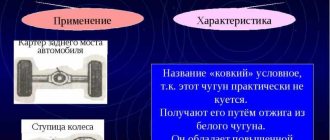Defect correction methods
Minor defects are corrected by sealing with putties or mastics, impregnation with various compounds, gas or electric welding.
Sealing with putties or mastics is a decorative correction of small surface cavities. Before filling with mastic, defective areas are cleaned of dirt and degreased. After filling, the corrected area is smoothed, dried and rubbed with pumice or graphite.
Impregnation is used to eliminate porosity. The castings are immersed in an aqueous solution of ammonium chloride for 8-12 hours. Penetrating into the spaces between the metal crystals, the solution forms oxides that fill the pores of the castings.
Gas and electric welding are used to correct defects on untreated surfaces (sinks, cracks). Defects in cast iron castings are welded using cast iron electrodes and filler rods, in steel castings - with electrodes of the appropriate composition
Basic recommendations for choosing a casting method
When comparing different casting methods, the following factors must be considered.
Technological properties of the alloy.
It is not advisable to use casting in metal molds:
- with reduced fluidity of the metal, because high cooling rates lead to rapid cooling and crystallization of the molten metal, which can cause the formation of underfills and joints;
- with a high tendency of the material to shrink, since cracks may form due to the low compliance of the mold, which prevents the free shrinkage of the casting in the mold.
Complexity of the casting shape.
Depending on the configuration, size, weight and required number of rods, castings are divided into six complexity groups. The simplest castings belong to the first group, which is characterized by smooth and straight outer surfaces with the presence of low reinforcing ribs, flanges, holes, as well as simple internal surfaces. Typical products are covers, flanges, couplings, trolley wheels. The most complex castings belong to the sixth group, which is characterized by curved outer surfaces having ribs, brackets and flanges of considerable length, intersecting each other at different angles, as well as internal cavities of a particularly complex configuration with difficult exits to the surface of the casting. Typical products are the beds of special metal-cutting machines, complex pump casings, and hydraulic turbine impellers.
Castings with complex configurations are produced by injection molding, investment casting, or sand molds. Chill casting produces castings with a simple external configuration, and centrifugal casting produces castings of the type of rotating bodies. The thinnest-walled castings are produced by investment casting and injection molding.
3. Quantity.
In conditions of large-scale or mass production, casting methods using metal or shell molds are cost-effective. But if it is necessary to produce one or just a few castings (single production), then it is irrational to make an expensive mold for this or use expensive lost-wax casting. Therefore, in this case, the use of sand casting, for which inexpensive wooden models can be used, can pay off and is the most rational.
4. Required geometric accuracy and surface quality.
You should choose a method that ensures the specified dimensional accuracy and surface roughness. The high quality of the surface makes it possible to either eliminate subsequent machining or perform it with minimal allowances. This makes it possible to preserve the casting skin during machining, which has increased hardness and wear resistance, and to reduce the cost of finished parts by saving metal. However, this increases the costs of foundry equipment and accessories, their repair and maintenance. Therefore, when choosing a method for producing a casting, a technical and economic analysis should be carried out not only of one blank (foundry), but of two stages of production - blank (foundry) and machining.
The most accurate indicator that determines the effectiveness of using a particular method is the cost of the product.
When choosing the optimal method for producing castings, as a rule, it is necessary to conduct a comparative analysis of possible casting options and their technological indicators, approximately presented in table. 1L.
Educational materials
It is used for steel casting, as well as for producing castings from non-ferrous metals and their alloys with small part sizes (for example, parts of sewing machines, cutting tools of complex shapes made of very hard materials, parts of guns, small parts of counting machines). This method provides a very high degree of accuracy up to ±0.005 mm per 25 mm of casting length, after which almost no mechanical reworking is required.
The essence of the method is that the model is made from easily fusible materials: stearin, paraffin, wax, rosin, or more often from a mixture of these materials.
After obtaining the mold, by drying and calcining these molds, the model in the mold melts and its composition is poured out of the mold, thus the mold is one-piece, solid, which ensures high accuracy of castings. The molding mixture consists of fine pulverized sand, a small amount of kaolin and an aqueous solution of liquid glass (Na2O·SiO2), i.e. represents a creamy mass. The paraffin-stearic model, made in special molds to obtain the shape, is immersed in this mixture. As a result, a thin mold crust (0.5÷2 mm thick) is formed on the surface of the model, which is sprinkled with fine sand.
Such a finished mold with the model inside is air-dried for 5–6 hours, and then placed in a special drying cabinet with the gating system down, where at temperatures up to 200°C the model melts and flows out of the mold. To harden the mold, it is then placed in an oven, where it is calcined at 3800–900°C. In this case, the remaining composition of the model burns out. To prevent the mold from being destroyed during metal pouring, it is placed in special boxes made of sheet steel and covered with sand. The gating system is usually done after the mold itself has been received. Moreover, due to the small size of the parts, several molds are blocked and connected into a common gating system. After pouring liquid metal into such a mold and hardening it, the mold is destroyed.
The advantage of casting according to models
The positive qualities of the technological process include high precision casting of the part up to class 4 accuracy with a clean surface that does not require additional processing. An important feature of the method is also the ability to obtain a product of complex configuration, the usual manufacturing method of which would require assembly from individual elements. Manufacturing castings from hard metal alloys makes it possible to obtain products with surface roughness up to class 6 from Rz=20 microns to Ra=1.25 microns in accordance with the requirements of GOST 2789–59.
How the process is carried out
In the serial production of small or large parts, a sketch and drawing of the product is developed, a mock-up and a mold are made, and materials from metal, gypsum, and refractory clay are selected. The production process is carried out in the following sequence :
- assembly of a split mold;
- a heated waxy mass of a fusible substance (paraffin, stearin, wax) is poured into the mold hole under a pressure of 2.5-3 atm;
- After cooling, the workpieces are connected into blocks by soldering with a gating system.
The principle of lost wax casting is to produce a material based on a one-piece mold that ensures high precision of the finished product. The chosen casting method helps to obtain parts with a wall thickness of 0.5 mm from steel of a refractory alloy that cannot be machined.
Supply of stainless steel castings
Our company supplies manufactured stainless steel products to all cities of Russia with the help of transport companies. Stainless steel castings are sent to: Aginskoye, Adler, Alexandrovsk, Amursk, Angarsk, Arzamas, Armavir, Arsenyev, Astrakhan, Achinsk, Akhtubinsk, Achinsk, Baikalsk, Balashikha, Barnaul, Bataysk, Belgorod, Beloretsk, Berezniki, Birobidzhan, Blagoveshchensk, Bryansk, Bugulma, Veliky Ustyug, Vladivostok, Vladimir, Vladikavkaz, Volgograd, Volgodonsk, Vologda, Volkhov, Voronezh, Votkinsk, Voskresensk, Vyazma, Glazov, Golitsyno, Gus-Khrustalny, Dzerzhinsk, Dubna, Yegoryevsk, Ekaterinburg, Yelabuga, Yeisk, Yeniseisk, Ershov , Zheleznogorsk, Zelenograd, Zvenigorod, Ivanovo, Yoshkar-Ola, Kazan, Kaluga, Kamensk-Uralsky, Kaspiysk, Kirov, Klin, Kolomna, Kovrov, Kostroma, Krasnodar, Kuznetsk, Lipetsk, Labinsk, Lyubertsy, Mozhga, Moscow, Murom, Murmansk , Naberezhnye Chelny, Nazran, Neftegorsk, Neftekamsk, Nizhnevartovsk, Nizhny Novgorod, Nizhnekamsk, Novokuznetsk, Novorossiysk, Novocherkassk, Novosibirsk, Orel, Orekhovo-Zuevo, Orenburg, Orsk, Pavlovsky Posad, Penza, Petropavlovsk-Kamchatsky, Pskov, Rybinsk, Ryazan, Samara, Sarapul, St. Petersburg, Saratov, Saransk, Sasovo, Sarov, Sergiev Posad, Snezhinsk, Smolensk, Sterlitamak, Tambov, Tomsk, Tula, Tyumen, Ulyanovsk, Ufa, Khanty-Mansiysk, Khabarovsk, Yakutsk, Yaroslavl, Chelyabinsk and others .
Advantages of cast parts
The advantage of the model-based production method is the ability to use cost-effective non-destructive technology for the production of a range of single, serial or mass products with high requirements for dimensional accuracy and cleanliness of finish. Lost wax low-melting models for small-shaped parts, complex configurations and large products are made from organic materials :
- paraffin;
- ceresin;
- stearin;
- peat bitumen;
- polystyrene;
- rosin;
- lignite wax;
- polyethylene;
- ozokerite, etc.
When choosing a model composition, the complex of physical properties of the material is taken into account. Lost wax models must meet the following requirements :
- fusibility at temperatures from 60 0 C to 100 0 C;
- minimal shrinkage and expansion;
- good fluidity;
- mechanical strength;
- minimal ash content and sticking to objects and hands;
- chemical inertness;
- environmental safety;
- possibility of reuse;
- good adhesion with facing liquid;
- the possibility of mechanization and automation of the process;
- economical consumption of metal.
The lost wax process makes it possible to produce parts from alloy and carbon steel, non-ferrous alloy or cast iron. The method of casting metal into tooling produces a chill mold, stamp, mold, core or molding equipment, car parts and small arms. The production of castings in a split ceramic mold (slip) is carried out in several stages :
- pouring suspension into the flask;
- mold hardening;
- extracting the resulting model from the hemisphere;
- thermal calcination of the half-mold;
- assembly and filling of half-molds with molten metal.
Casting alloy selection
The modern process of making castings from models involves a serious approach to the choice of casting alloy. They are made from various casting alloys: carbon and alloyed, corrosion-resistant, heat-resistant and heat-resistant steels, non-ferrous alloys and cast iron-based compositions.
When producing foundry products, the conditions in which they will function are taken into account. The material of the castings depends on this. Thus, for the production of highly hermetic housings, a metal is selected that is not prone to the formation of shrinkage looseness and porosity. For components requiring high heat resistance - nickel compounds.
When choosing a casting alloy, it is necessary to have a complete understanding and exact requirements for the casting material. Clearly group the working conditions and purpose of future parts. This will make it possible to most correctly select the required alloy, taking into account its specific characteristics.
Automated production
The lost wax casting process, the technology of which is adapted for automatic installation, simultaneously allows the production of a riser and funnel for the gating system.
The state standard imposes the same requirements on metal castings as on products produced by other methods. Melting of the working material is carried out using factory technology.
The casting is knocked out after cooling the mold on a pneumatic installation with the flask rotated 180 C to remove the bulk filler. The workpiece is separated in several ways:
- vibration on a special platform;
- by pressing through the cut form of the stamp;
- cutting with power tools;
- anodic and mechanical cutting.
Cleaning of workpieces from the slip shell is carried out by leaching with a hot KOH solution. Residual fragments are cleaned with tools with a brush or emery attachment.
The degree of cleanliness of the casting surface depends on the condition and design of the mold, the type of model composition, the fraction of quartz sand, the method of melting the composition and the calcination mode of the shells, and the chemical composition of the casting.
The density of the casting material is determined by the position of the mold on the working platform. Compensation for steel shrinkage during the hardening process is ensured by the design of the supply system. The accuracy of the metal casting is checked by an optical comporator. The disadvantages of model casting include the complexity and duration of the technological process, and the high cost of equipment.
Machines for preparing model composition
At the beginning of the technological chain, a model composition is prepared. For this, an automatic machine 61701 is used, consisting of devices for supplying solid and liquid components of the mixture, dispensers, containers and mixers. Low-melting model compositions are prepared by melting the components in water or oil baths with electrical heating.
Air in an amount of 8 is mixed into the model composition. . .12% of volume For this purpose, gear, piston and paddle mixers are used.
Rice. 4. Diagram of a gear mixer for preparing a paste-like model composition with air: 1 - shafts; 2 — wheels; 3 - partitions; 4 — outlet; 5 – mixer drive
Continuous gear mixers (Fig. 4) have two shafts 1 on which gears 2 are mounted. Each pair of wheels is separated from the adjacent one by a partition 3. In each pair, one of the wheels is loosely mounted on the shaft, and the second is secured to the shaft with a key; in the adjacent pair, it is the other way around. The shafts rotate from a common drive 5 in one direction. Therefore, on one shaft, even and on the other, odd gears rotate along with the shaft, setting the freely mounted paired wheels in motion. Adjacent pairs of wheels rotate in different directions. The width of each pair decreases in the direction of movement of the model composition to create pressure and move the paste. The liquid model composition is fed into the neck of the mixer along with air and, after mixing by the first pair of wheels, is squeezed out through hole 4 in partition 3 into the adjacent section, where it is mixed in the opposite direction and moves upward to hole 4 in the next partition. During the mixing process, the model composition is intensively cooled, turning into a paste-like state.
Advantages and disadvantages of lost wax casting
In this section we will analyze two casting methods. According to lost wax models and the new LGM method.
The advantages of this method: the ability to manufacture parts from alloys that cannot be machined; obtaining castings with dimensional accuracy up to 11-13 quality and surface roughness Ra 2.5-1.25 microns, which in some cases eliminates cutting processing; the possibility of obtaining machine components that, with conventional casting methods, would have to be assembled from individual parts. Lost wax casting is used in conditions of single (pilot), serial and mass production.
Disadvantages of this method: relatively high cost of molding materials; complexity of model equipment; increased release of harmful chemicals during thermal removal of the model substance, the mechanical properties of cast metals and alloys are lower, porosity is higher, the presence of internal defects is possible, and others.
Standard prices
| Product | Production time | Price |
| Bronze blank 3 kg | 2-3 days | 1620 rub. |
| Cast stand blanks | 5 days | 450 rub. |
| Iron casting | 5 days | 90 RUR/1 kg |
| Aluminum casting | 5 days | 290 RUR/1 kg |
| Bronze casting | 5 days | 540 RUR/1 kg |
Senior Specialist. Assistance in estimating the cost and production time of products made of bronze, aluminum and cast iron.

